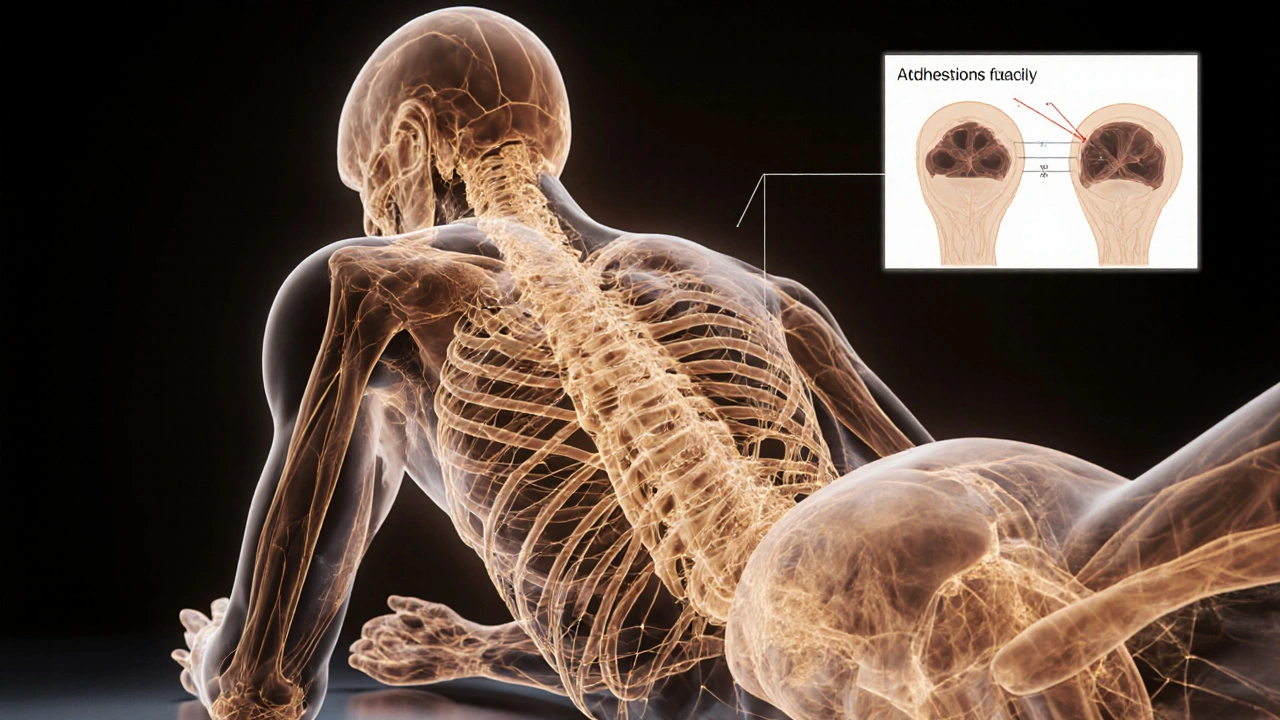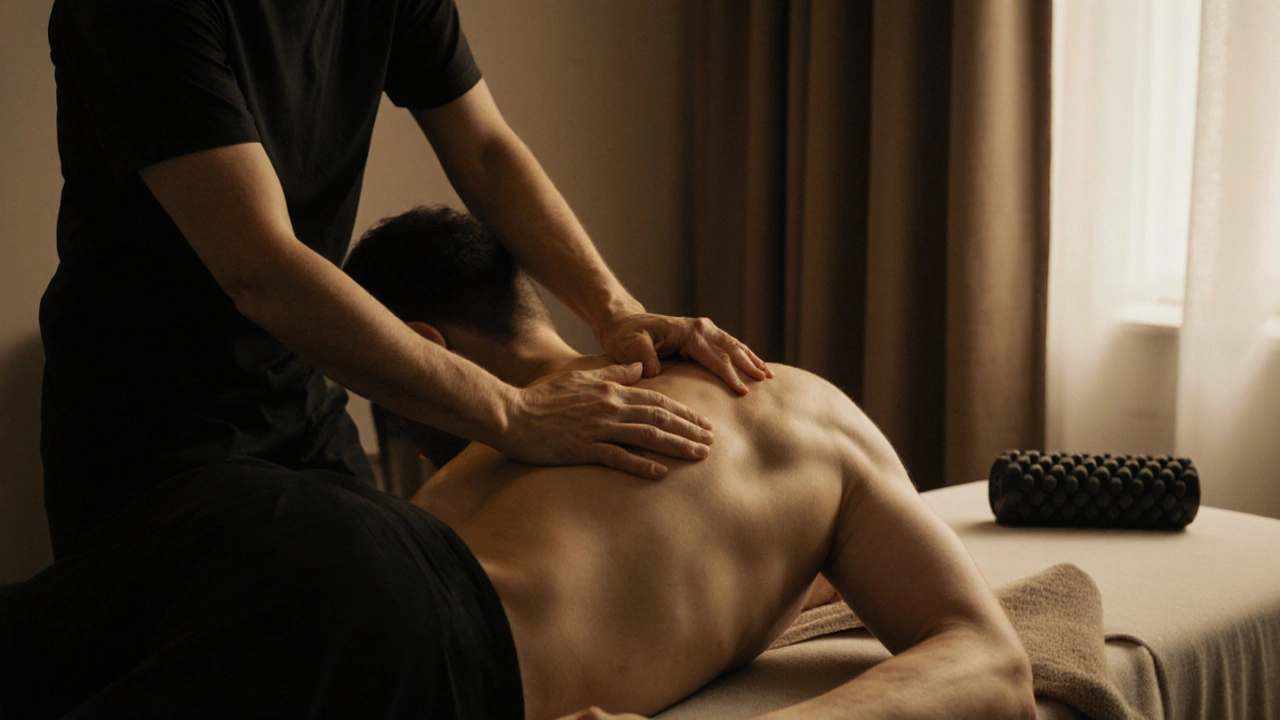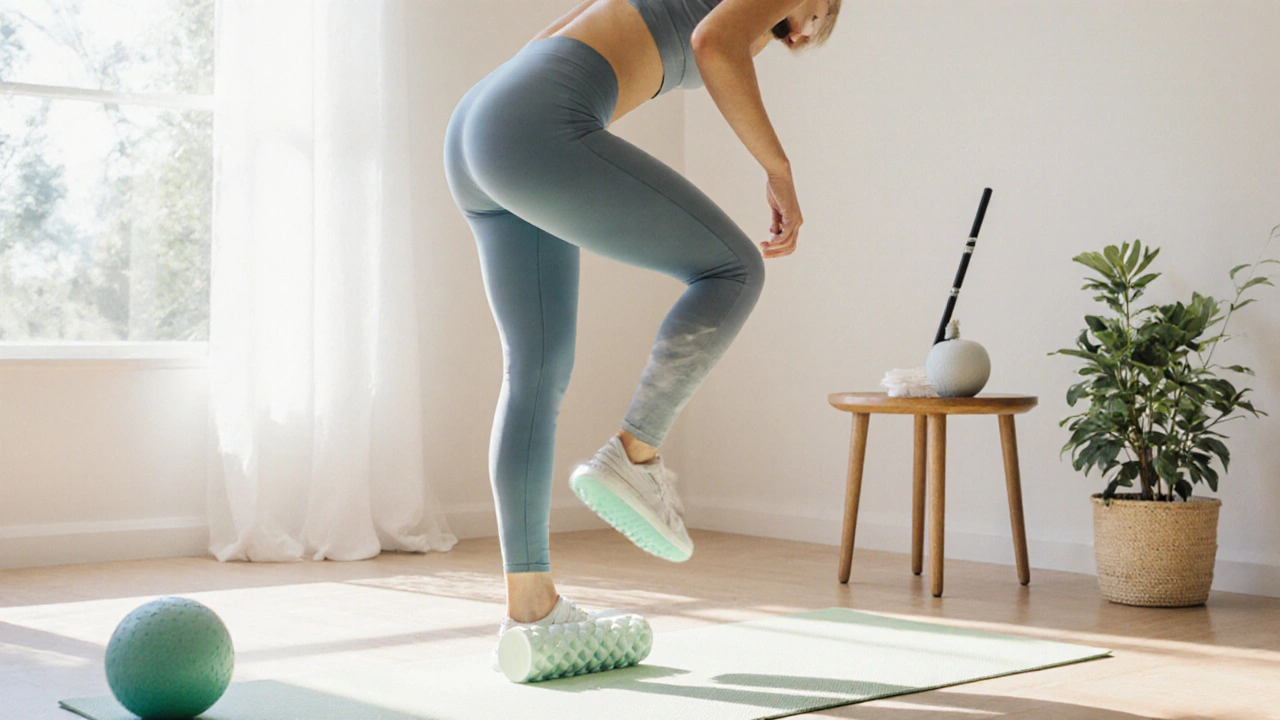Myofascial Release Therapy: Benefits, Techniques & How It Works

Self-Myofascial Release Guide
Find Your Release Technique
Select your area of tension to get personalized guidance for effective self-myofascial release.
Ever wonder why a single stretch or a few minutes on the mat can melt away nagging aches? The secret often lies in the web of tissue that runs through every muscle, bone and organ - the fascia. When that web gets stuck, we feel it as tension, pain or limited motion. Myofascial Release Therapy is a hands‑on approach that targets those stuck spots, loosening the fascia so the body can move freely again. It’s not just a trendy buzzword; it’s a technique backed by biomechanics, sports science and real‑world results.
What Is Myofascial Release Therapy?
At its core, myofascial release therapy is a form of manual therapy that applies gentle, sustained pressure to the fascia - the connective tissue that surrounds muscles, nerves, blood vessels and organs. Practitioners use their hands, elbows or specialized tools to locate restrictions, then hold the pressure until the tissue softens. Unlike a quick Swedish massage stroke, the pressure is slower, deeper and held for 90‑to‑120 seconds per spot. The goal isn’t just relaxation; it’s to restore the fascia’s natural glide and elasticity.
How It Works: The Science of Fascia
Fascia is a continuous, three‑dimensional network made of collagen, elastin and water. When healthy, it slides like a well‑lubricated cable, transmitting force and protecting structures. Injury, poor posture, dehydration or repetitive motion can cause micro‑tears, leading to adhesions - areas where fibers stick together. These adhesions create what practitioners call "trigger points" that refer pain to other parts of the body.
Research from the National Center for Complementary and Integrative Health (2023) shows that sustained pressure can remodel collagen fibers, increase blood flow and reduce inflammatory markers. In plain terms, the therapist’s steady pressure nudges the scar tissue to re‑align, breaking the pain cycle.
Below are the key physiological changes that happen during a session:
- Increased tissue temperature - heat loosens collagen fibers.
- Improved perfusion - more oxygen and nutrients reach the area.
- Reduced neural firing - the brain receives fewer pain signals.
- Enhanced proprioception - the nervous system relearns correct movement patterns.
Key Benefits You’ll Feel
People who try myofascial release often report a mix of immediate relief and longer‑term improvements. Here’s what the science and client stories agree on:
- Pain reduction: A 2022 randomized trial of 120 chronic low‑back patients showed a 42% drop in pain scores after eight weekly sessions.
- Increased range of motion: Runners who received fascia work logged a 15% boost in hip flexibility within two weeks.
- Faster recovery: Athletes report fewer days off after games when they incorporate weekly fascia sessions.
- Better posture: Office workers notice reduced slouching after just three sessions because the thoracic fascia relaxes.
- Stress relief: The gentle, sustained touch triggers parasympathetic activation, lowering cortisol.

Common Techniques & Session Flow
While each therapist tailors the treatment, most sessions follow a predictable pattern. Below is a typical flow you might experience:
- Assessment: The practitioner asks about pain history, movement limits and lifestyle. They may palpate key areas to locate adhesions.
- Targeting the fascia: Using hands or a small foam roller, the therapist applies slow pressure to a restricted zone. Pressure is increased gradually until a “softening” sensation is felt.
- Hold & release: The pressure is held for 90‑120 seconds, allowing the tissue to unwind. Sometimes a gentle stretch is added during the hold.
- Integration: After the release, the client moves through functional movements (e.g., arm circles, hip hinges) to reinforce the new tissue length.
- Home advice: Simple self‑myofascial tools (like a lacrosse ball) or stretches are recommended for daily maintenance.
Typical session length ranges from 45 minutes to 90 minutes, depending on the number of areas addressed.
Who Can Benefit? Common Conditions Treated
Myofascial release is versatile. Below are the most frequent complaints that improve with consistent treatment:
- Myofascial Pain Syndrome - a chronic pain condition triggered by trigger points.
- Chronic low‑back pain - especially when imaging shows no major structural damage.
- Neck and shoulder tension - common in desk‑workers and gamers.
- Plantar fasciitis - inflammation of the foot’s fascia.
- Sports‑related injuries - like IT‑band syndrome, shin splints or tennis elbow.
- Post‑surgical scar tissue - helps soften adhesions after abdominal or orthopedic surgery.
People with severe osteoporosis, acute fractures or active infections should consult a medical professional before starting any manual therapy.
How to Choose a Qualified Practitioner
Not every massage therapist is trained in fascia work. Look for these credentials:
- Certification in Myofascial Release (e.g., from the MFR Institute).
- Background in anatomy or a related health field (physical therapy, chiropractic, osteopathy).
- Experience with your specific condition (ask for case studies or client testimonials).
- Clear communication - a good practitioner will explain what they’re doing and why.
- Clean, professional environment with proper sanitation practices.
Don’t be shy about asking about continuing education. The field evolves quickly, and many therapists attend workshops on integrating fascia work with mobility training.

At‑Home Self‑Care: Simple Myofascial Hacks
Consistency is key. Even a few minutes a day can keep fascia supple. Here are three budget‑friendly tools you can buy at a local sports store:
- Lacrosse ball: Ideal for small, hard‑to‑reach spots like the glutes or forearm.
- Foam roller: Works great on larger muscle groups like the calves, hamstrings and thoracic spine.
- Handheld massage stick: Perfect for the quadriceps and lower back when you’re on the go.
Try the “3‑minute roll” routine: spend 30 seconds on each major area (upper back, lower back, hips) with slow, controlled rolls. Follow each roll with a gentle stretch - for example, the cat‑cow stretch after rolling the thoracic area.
Myofascial Release vs. Other Hands‑On Modalities
| Therapy | Primary Goal | Typical Pressure | Session Length | Best For |
|---|---|---|---|---|
| Myofascial Release | Release fascia adhesions | Gentle, sustained (90‑120 s per spot) | 45‑90 min | Chronic pain, limited ROM |
| Swedish Massage | Relaxation & circulation | Light to medium, rhythmic | 60‑90 min | Stress relief, general wellness |
| Trigger Point Therapy | Deactivate painful knots | Firm, short bursts | 30‑60 min | Acute trigger points, sports injuries |
While there’s overlap, Myofascial Release uniquely focuses on the connective tissue’s glide, making it especially effective for long‑standing stiffness that other modalities only mask.
Frequently Asked Questions
Is myofascial release painful?
Most clients describe a mild discomfort that fades as the tissue relaxes. If the pressure feels sharp, the therapist should adjust - the goal isn’t to hurt but to release tension.
How many sessions will I need?
It varies. Acute issues might improve after 2‑4 sessions, while chronic conditions often require 6‑12 visits combined with home care.
Can I combine myofascial release with other therapies?
Absolutely. Many athletes pair it with mobility drills, strength training, or acupuncture for a holistic recovery plan.
Is it safe for pregnant women?
When performed by a practitioner trained in prenatal care, gentle myofascial work can alleviate back and pelvic discomfort safely.
Do I need any special equipment at home?
A simple lacrosse ball or foam roller works fine. The key is consistent, slow pressure, not fancy gadgets.
Ready to give your fascia the attention it deserves? Start with a qualified practitioner, add a quick daily roll, and watch how your body slowly regains its natural freedom of movement.





